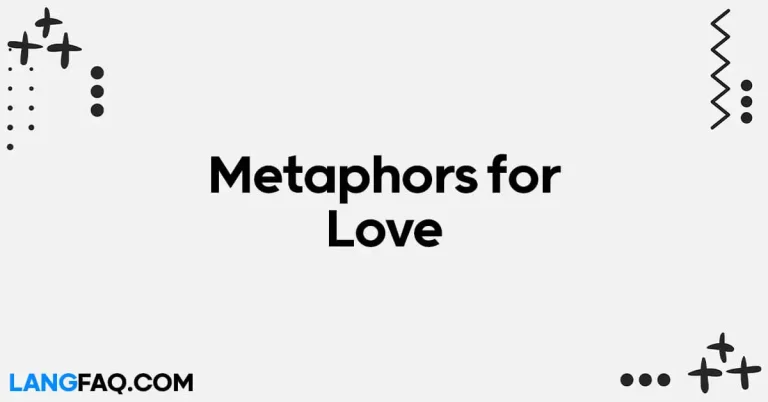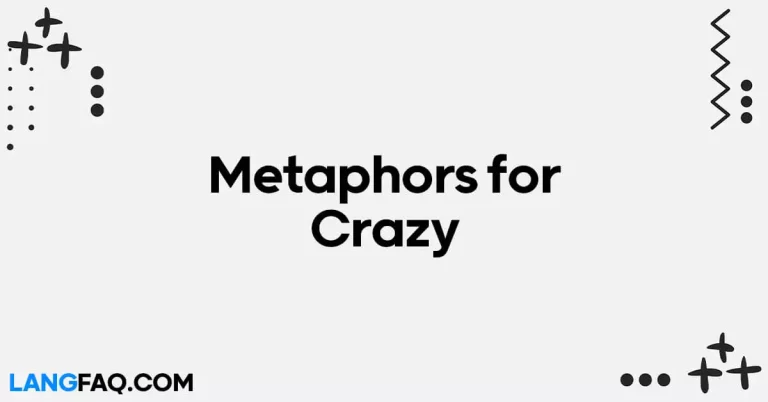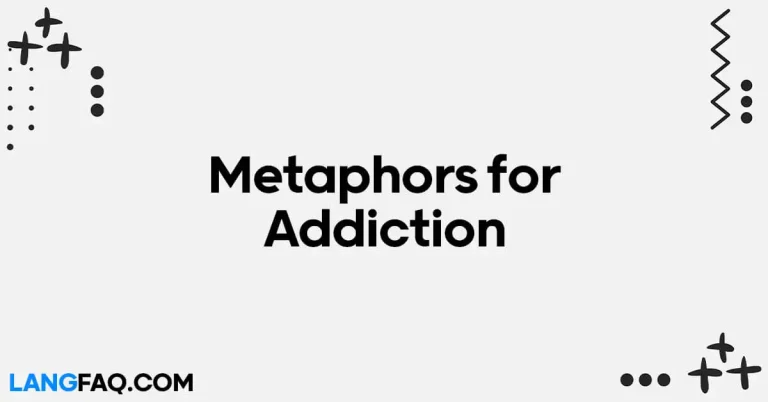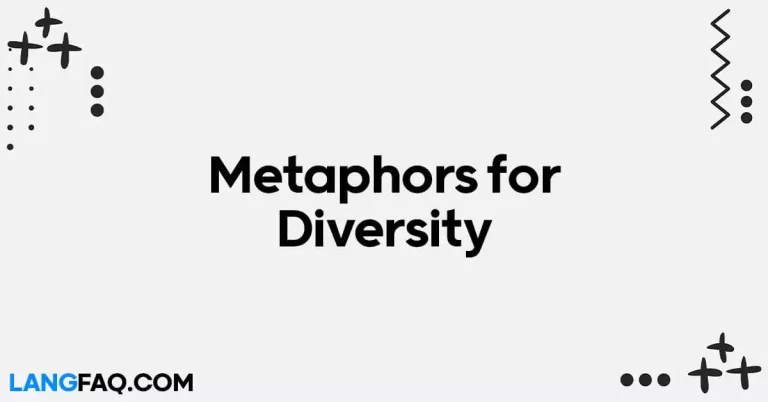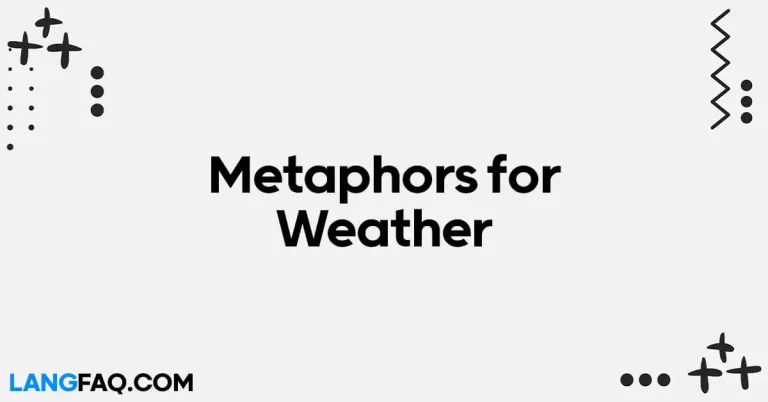Dreams, the ethereal landscapes of our subconscious, have fascinated humans for centuries. In this article, we delve into the poetic realm of metaphors, unraveling 26 captivating expressions that encapsulate the essence of dreams. Join us on this journey through the vast, imaginative tapestry of the sleeping mind.
26 Metaphors for Dreams
- The Symphony of Slumber: Dreams orchestrate a symphony, each note a manifestation of the subconscious mind’s creativity.
- Celestial Canvas of Night: The night sky transforms into a celestial canvas, painting dreams with the radiant hues of stars and the moon.
- Echoes of the Unconscious: Dreams resonate through the corridors of the unconscious mind, shaping thoughts like whispers in the dark.
- The Tapestry of Fantasia: Dreams intertwine to create an intricate tapestry, weaving a fantastical landscape of imagination.
- Dance of the Nebulae: Dreams twirl and pirouette like cosmic nebulae, leaving an indelible mark on the night.
- Fluttering Pages of Morpheus: Dreams flutter like ethereal butterflies, each page telling a unique story in Morpheus’s book.
- Enchanted Reverie: Dreams take on a magical quality, blurring the lines between reality and fantasy in an enchanted realm.
- Mirage of the Mind: Dreams shimmer like desert illusions, teasing the senses with their elusive beauty.
- Sailing on the Sea of Serenity: Dreams become waves, carrying the mind on a voyage across the Sea of Serenity to distant shores of imagination.
- Lanterns in the Night: Dreams light up the night like lanterns, guiding the mind through the darkness with their luminous glow.
- Dreams Through the Kaleidoscope: Each turn of the kaleidoscope reveals a new pattern of thoughts, emotions, and experiences within dreams.
- Whispers of the Nightingale: The nightingale’s song captures the beauty of dreams, its melody echoing the subtleties of the subconscious.
- The Phoenix’s Ascent: Dreams rise from the ashes like the phoenix, embodying resilience and the endless cycle of imagination.
- A Tapestry of Stars: Dreams are woven into the fabric of the cosmos, creating a celestial masterpiece in the night sky.
- The Silent Pantomime: Dreams unfold in a silent pantomime, where gestures and expressions convey emotions in the absence of words.
- Bridging Realms: Dreams act as bridges connecting the conscious and unconscious, facilitating a free flow of ideas and inspirations.
- Navigating the Labyrinth of Dreams: The mind journeys through the labyrinth of dreams, each twist and turn revealing new facets of the subconscious.
- The Quill of Morpheus: Morpheus’s quill crafts intricate stories on the parchment of the sleeping mind, giving life to dreams.
- A Symphony of Colors: Dreams paint the mind’s canvas with vibrant hues and shades, creating a symphony of colors.
- Chronicles of the Pillow: Dreams inscribe tales of adventure, love, and fantasy on the soft fabric of night, forming the chronicles of the pillow.
- The Echoing Footsteps: Dreams leave behind echoing footsteps, each step resonating with the untold stories of the subconscious.
- The Unseen Puppeteer: An unseen puppeteer orchestrates the dance of dreams with invisible strings, shaping narratives in the shadows.
These metaphors provide vivid imagery and poetic language to convey the diverse experiences and qualities associated with the realm of dreams.
| Symphony of Slumber | Dreams as a harmonious orchestration of subconscious creativity | The dream unfolded like a symphony, each scene a note in the composition. |
| Celestial Canvas of Night | The night sky transforming into a canvas for dream imagery | The stars painted a celestial canvas of dreams overhead. |
| Echoes of the Unconscious | Dreams resonating through the corridors of the unconscious mind | The echoes of his dreams lingered long after he woke. |
| Tapestry of Fantasia | Dreams interwoven to create an intricate tapestry of imagination | The dreamworld unfolded, revealing a tapestry of fantastical scenes. |
| Dance of the Nebulae | Dreams twirling and pirouetting like cosmic nebulae in the night sky | Her dreams danced in the night, a cosmic ballet of imagination. |
| Fluttering Pages of Morpheus | Dreams unfolding like pages in Morpheus’s book | Each night, the pages of Morpheus’s book fluttered with new dreams. |
| Enchanted Reverie | Dreams taking on a magical quality, blurring reality and fantasy | The dream carried her into an enchanted reverie of mystical landscapes. |
| Mirage of the Mind | Dreams shimmering like elusive mirages in the desert | The dreams played tricks on the mind, a mirage of shifting emotions. |
| Sailing on the Sea of Serenity | Dreams as waves carrying the mind on a serene voyage | His mind sailed on the sea of serenity, guided by the currents of dreams. |
| Lanterns in the Night | Dreams lighting up the darkness like lanterns | The night was adorned with dreams, glowing like lanterns in the dark. |
| Dreams Through the Kaleidoscope | Dreams viewed as ever-changing patterns and experiences | Each night, the kaleidoscope of dreams revealed new and vibrant patterns. |
| Whispers of the Nightingale | Dreams likened to the subtle and melodic whispers of a nightingale | The dreams were soft whispers of the nightingale, carrying secrets of the subconscious. |
| The Phoenix’s Ascent | Dreams rising from the ashes, symbolizing resilience | Her dreams were like the phoenix, ascending with renewed vigor and creativity. |
| A Tapestry of Stars | Dreams woven into the cosmic fabric, creating a celestial masterpiece | The night sky became a tapestry of stars, each one representing a dream. |
| The Silent Pantomime | Dreams unfolding like a silent performance, conveying emotions without words | The dream was a silent pantomime, expressing a range of emotions without a sound. |
| Bridging Realms | Dreams acting as bridges connecting the conscious and unconscious | In the realm of dreams, bridges formed, connecting worlds of reality and imagination. |
| Navigating the Labyrinth of Dreams | Dreams as a complex and intricate labyrinth of the subconscious | His mind navigated the labyrinth of dreams, discovering new insights at every turn. |
| The Quill of Morpheus | Dreams crafted by Morpheus’s quill, symbolizing the artistry of dreams | Morpheus’s quill wrote intricate stories on the canvas of the dreamer’s mind. |
| A Symphony of Colors | Dreams painting the mind’s canvas with vibrant hues | The dream was a symphony of colors, each emotion expressed in a different shade. |
| Chronicles of the Pillow | Dreams inscribing tales on the pillow, representing the stories of the night | The pillow held the chronicles of his dreams, each night leaving a new story to tell. |
| The Echoing Footsteps | Dreams leaving behind resonant footsteps of memories | The echoing footsteps of dreams lingered in his mind, leaving imprints of the night. |
| The Unseen Puppeteer | Dreams orchestrated by an unseen puppeteer, shaping narratives | The mind’s dreams danced to the tune of an unseen puppeteer, crafting stories in the shadows. |
1. The Symphony of Slumber: Embracing the Harmonious Dreamscape
Dreams, like a symphony, weave intricate melodies within the realm of our slumber. This metaphor encapsulates the idea that our dreams are a harmonious orchestration of our subconscious creativity. Just as a symphony comprises various musical elements, dreams bring together diverse thoughts, emotions, and experiences into a cohesive composition.
Usage Scenarios:
- Formal Context (Work Colleagues): “In our brainstorming session, let’s approach this project with the creativity and harmony akin to a symphony of slumber.”
- Informal Context (Friends): “Last night’s dreams were like a symphony of slumber, with each scene blending seamlessly into the next.”
Example Sentence: “Her dreams unfolded like a symphony of slumber, each scene a note in the composition of her subconscious mind.”
Grammar/Usage Tip: While using this metaphor, ensure that the context aligns with creativity, collaboration, or the seamless integration of various elements.
Dictionary Insight: The term “symphony” denotes a harmonious arrangement of elements, making it a fitting metaphor for the intricate nature of dreams.
2. Celestial Canvas of Night: Painting Dreams with Cosmic Imagery
Imagine the night sky transforming into a celestial canvas, where dreams are painted with the radiant hues of stars and the moon. This metaphor emphasizes the grandeur and beauty of the dreamworld, suggesting that each dream is a unique stroke on the cosmic canvas of the night.
Usage Scenarios:
- Formal Context (Professional Setting): “Our marketing strategy should be as captivating as the celestial canvas of night, with each campaign adding a unique touch.”
- Informal Context (Family): “Let’s share our dreams at the dinner table, turning the evening into a celestial canvas of night filled with stories.”
Example Sentence: “As she gazed at the stars, she felt her dreams painting the celestial canvas of night with tales of adventure and wonder.”
Grammar/Usage Tip: Use this metaphor when describing the beauty or uniqueness of dreams, particularly in contexts related to creativity, storytelling, or inspiration.
Dictionary Insight: “Celestial” refers to the heavens or the sky, adding a cosmic and transcendent quality to the metaphor.
3. Echoes of the Unconscious: Resonating Whispers in the Dark
In the quiet corners of our minds, dreams unfold like echoes, leaving behind resonating whispers in the dark. This metaphor suggests that dreams have a lingering presence, much like the subtle echoes that persist even after the original sound has faded away.
Usage Scenarios:
- Formal Context (Academic Presentation): “Exploring the echoes of the unconscious mind can provide profound insights into the study of dreams.”
- Informal Context (Friends): “Let’s delve into the echoes of our dreams from last night; those whispers in the dark hold secrets.”
Example Sentence: “Even in the silence of the night, the echoes of her dreams resonated like whispers in the dark, revealing hidden emotions and desires.”
Grammar/Usage Tip: This metaphor works well when emphasizing the lasting impact or subtle influence of dreams.
Dictionary Insight: “Echoes” signify sounds or voices that reverberate, aligning with the idea of persistent, subtle elements in the metaphor.
4. The Tapestry of Fantasia: Weaving Dreams into a Fantastical Landscape
Our minds craft dreams as if weaving an intricate tapestry of fantasia, where each thread represents a unique element of imagination. This metaphor portrays dreams as part of a larger, fantastical creation, each contributing to the overall beauty and complexity.
Usage Scenarios:
- Formal Context (Creative Workshop): “Let’s approach our design concepts like we’re weaving a tapestry of fantasia, where each element tells a captivating story.”
- Informal Context (Family Gathering): “Sharing our dreams is like adding threads to the tapestry of fantasia in our collective imagination.”
Example Sentence: “As he slept, his mind worked tirelessly, weaving the tapestry of fantasia with dreams that blended reality and whimsy in a seamless dance.”
Grammar/Usage Tip: Use this metaphor when emphasizing the collaborative or interconnected nature of dreams within a broader context.
Dictionary Insight: “Tapestry” symbolizes a rich, woven fabric, reflecting the intricate and interconnected nature of dreams.
5. Dance of the Nebulae: Twirling Dreams in the Cosmic Ballet
Envision dreams as ethereal dancers, twirling and pirouetting like nebulae in a cosmic ballet. This metaphor captures the graceful and mesmerizing movements of dreams, highlighting their cosmic and otherworldly qualities.
Usage Scenarios:
- Formal Context (Artistic Presentation): “Our performance should embody the dance of the nebulae, with each movement expressing the beauty of our collective dreams.”
- Informal Context (Friends): “Last night’s dreams were like a cosmic ballet, twirling through the night sky with grace and beauty.”
Example Sentence: “In the quiet hours before dawn, the dance of the nebulae unfolded, with dreams swirling like celestial dancers in a cosmic ballet.”
Grammar/Usage Tip: This metaphor suits contexts that emphasize the beauty, grace, or artistic nature of dreams.
Dictionary Insight: “Nebulae” refers to vast clouds of gas and dust in space, adding a cosmic and celestial dimension to the metaphor.
6. Fluttering Pages of Morpheus: Unveiling Stories in a Dream Journal
Imagine dreams as pages fluttering in Morpheus’s book, each one revealing a unique story. This metaphor paints a vivid picture of dreams as written narratives, waiting to be explored and shared.
Usage Scenarios:
- Formal Context (Journalism Seminar): “Approach your investigative stories like you’re uncovering the fluttering pages of Morpheus, revealing hidden truths.”
- Informal Context (Book Club): “Let’s discuss our dreams as if they’re chapters from the fluttering pages of Morpheus’s book.”
Example Sentence: “As she woke, she reached for her dream journal, eager to capture the fluttering pages of Morpheus before the details faded away.”
Grammar/Usage Tip: Use this metaphor when emphasizing the narrative or storytelling aspects of dreams.
Dictionary Insight: “Morpheus” is the Greek god of dreams, adding a mythical and storytelling element to the metaphor.
7. Enchanted Reverie: Exploring the Magical Realms of Dreams
Step into the enchanted reverie where dreams take on a magical quality, blurring the lines between reality and fantasy. This metaphor transports us to a realm where dreams unfold as enchanting experiences, filled with wonder and mystery.
Usage Scenarios:
- Formal Context (Marketing Presentation): “Our campaign should transport the audience into an enchanted reverie, where dreams become magical experiences.”
- Informal Context (Family): “Let’s share our dreams over dinner, creating an enchanted reverie of fantastical stories.”
Example Sentence: “As she closed her eyes, the enchanted reverie began, and dreams transported her to magical realms where reality and fantasy danced in harmony.”
Grammar/Usage Tip: This metaphor is suitable for contexts that emphasize the magical, fantastical, or otherworldly aspects of dreams.
Dictionary Insight: “Enchanted” suggests a magical quality, aligning with the theme of dreams as mystical experiences.
8. Mirage of the Mind: Navigating Illusions in Dreamscapes
Dreams shimmer like elusive mirages, teasing the senses with their ephemeral beauty. This metaphor likens dreams to desert illusions, emphasizing their transient and sometimes elusive nature.
Usage Scenarios:
- Formal Context (Psychology Lecture): “Understanding the mirage of the mind in dreams requires delving into the illusions that shape our subconscious experiences.”
- Informal Context (Friends): “Last night’s dreams felt like a mirage of the mind, fading away as soon as I woke.”
Example Sentence: “In the depths of sleep, the mind navigated the mirage of dreams, where reality intertwined with illusions, creating a surreal landscape.”
Grammar/Usage Tip: Use this metaphor when discussing the transient or illusory qualities of dreams.
Dictionary Insight: “Mirage” refers to an optical illusion, highlighting the dreamlike and deceptive nature of the metaphor.
9. Sailing on the Sea of Serenity: Navigating Dreams like Ocean Waves
Embark on a voyage across the Sea of Serenity, where dreams are waves carrying the mind to distant shores of imagination. This metaphor paints dreams as a vast and serene ocean, inviting exploration and discovery.
Usage Scenarios:
- Formal Context (Leadership Seminar): “Leading a team is like sailing on the Sea of Serenity, navigating challenges with the serenity that dreams provide.”
- Informal Context (Family): “Let’s share our dreams tonight, sailing together on the Sea of Serenity and exploring the depths of our imagination.”
Example Sentence: “As he drifted into sleep, the mind set sail on the Sea of Serenity, with dreams carrying him to distant shores where imagination knew no bounds.”
Grammar/Usage Tip: This metaphor is effective in contexts that evoke a sense of exploration, tranquility, or vastness.
Dictionary Insight: “Serene” suggests a peaceful and calm quality, adding a soothing dimension to the metaphor.
10. Lanterns in the Night: Illuminating Darkness with Dream Glow
Discover how dreams light up the night like lanterns, guiding the mind through the darkness with their luminous glow. This metaphor emphasizes the illuminating and guiding qualities of dreams, much like lanterns in the night.
Usage Scenarios:
- Formal Context (Motivational Speech): “In challenging times, let your dreams be the lanterns in the night, guiding you through the darkness.”
- Informal Context (Friends): “Share your dreams with me, let them be the lanterns in the night that light up our conversations.”
Example Sentence: “As she closed her eyes, dreams became the lanterns in the night, casting a warm and guiding glow that led her through the mysterious corridors of the mind.”
Grammar/Usage Tip: Use this metaphor when discussing the guiding, comforting, or illuminating aspects of dreams.
Dictionary Insight: “Lanterns” symbolize sources of light, adding a metaphorical glow to the dream imagery.
11. Dreams Through the Kaleidoscope: Exploring Ever-Changing Patterns
Peering through the kaleidoscope of dreams reveals ever-changing patterns of thoughts, emotions, and experiences. This metaphor likens dreams to the colorful and dynamic patterns seen through a kaleidoscope, emphasizing the continuous evolution within the realm of slumber.
Usage Scenarios:
- Formal Context (Innovation Workshop): “Approach problem-solving like looking through the kaleidoscope of dreams, exploring diverse patterns for creative solutions.”
- Informal Context (Family Gathering): “Our minds are like a kaleidoscope of dreams, each experience adding a unique twist to the colorful patterns.”
Example Sentence: “As she drifted into sleep, her mind entered the kaleidoscope of dreams, where every shift brought forth new patterns, colors, and emotions.”
Grammar/Usage Tip: This metaphor suits contexts that highlight the dynamic, ever-changing nature of dreams.
Dictionary Insight: “Kaleidoscope” signifies a constantly changing sequence of elements, aligning with the metaphor’s emphasis on variability.
12. Whispers of the Nightingale: The Melodic Secrets of Dreams
Listen to the nightingale’s song, a metaphor for dreams that captures the beauty of the subconscious melody. This metaphor paints dreams as melodic whispers, echoing the subtleties and beauty found in the song of a nightingale.
Usage Scenarios:
- Formal Context (Art Appreciation Seminar): “Interpreting dreams is akin to deciphering the whispers of the nightingale, where every nuance adds to the melodic composition.”
- Informal Context (Friends): “Share your dreams with me; let’s unravel the whispers of the nightingale that linger in our subconscious.”
Example Sentence: “As the night deepened, dreams unfolded like the melodic whispers of a nightingale, each note carrying the secrets and beauty of the subconscious.”
Grammar/Usage Tip: This metaphor suits contexts that emphasize the lyrical or melodic qualities of dreams.
Dictionary Insight: “Nightingale” symbolizes a bird known for its beautiful song, adding a poetic and musical dimension to the metaphor.
13. The Phoenix’s Ascent: Dreams Rising from the Ashes
Witness the phoenix’s ascent as dreams rise from the ashes, embodying resilience and the endless cycle of imagination. This metaphor portrays dreams as a symbol of renewal and strength, rising triumphantly like a phoenix.
Usage Scenarios:
- Formal Context (Motivational Speaking): “Even in adversity, let your dreams be the phoenix’s ascent, rising from the ashes of challenges with renewed vigor.”
- Informal Context (Mentor-Mentee Conversation): “In setbacks, remember the phoenix’s ascent; let your dreams soar from the ashes of setbacks.”
Example Sentence: “After facing setbacks, her dreams became the phoenix’s ascent, rising from the ashes with newfound resilience and creative energy.”
Grammar/Usage Tip: Use this metaphor when discussing the themes of resilience, renewal, or overcoming challenges through the power of dreams.
Dictionary Insight: The phoenix is a mythical bird symbolizing rebirth, aligning with the metaphor’s theme of resilience and renewal.
14. A Tapestry of Stars: Dreams Woven into the Cosmic Fabric
Marvel at the tapestry of stars, where dreams are woven into the fabric of the cosmos, creating a celestial masterpiece. This metaphor likens dreams to threads in a cosmic tapestry, contributing to the vast and awe-inspiring creation of the night sky.
Usage Scenarios:
- Formal Context (Science Symposium): “Explore the tapestry of stars in your dreams, where each thought contributes to the cosmic fabric of your subconscious.”
- Informal Context (Family Gathering): “Let’s share our dreams tonight, adding threads to the tapestry of stars that adorn our collective imagination.”
Example Sentence: “In the quiet hours of the night, dreams were woven into the tapestry of stars, creating a celestial masterpiece that adorned the cosmic canvas.”
Grammar/Usage Tip: This metaphor is effective in contexts that evoke a sense of vastness, interconnectedness, or cosmic beauty.
Dictionary Insight: “Tapestry” signifies a rich, woven fabric, reflecting the intricate and interconnected nature of dreams in the metaphor.
15. The Silent Pantomime: Expressing Emotions Without Words
Experience the silent pantomime of dreams, where gestures and expressions convey emotions in the absence of words. This metaphor portrays dreams as a non-verbal performance, rich in emotional expression and communication.
Usage Scenarios:
- Formal Context (Communication Workshop): “Understanding dreams involves decoding the silent pantomime, where emotions are expressed without the need for words.”
- Informal Context (Friends): “Last night’s dreams felt like a silent pantomime, with emotions conveyed through subtle gestures and expressions.”
Example Sentence: “In the world of dreams, the mind engaged in a silent pantomime, expressing joy, sorrow, and love through gestures that needed no words.”
Grammar/Usage Tip: Use this metaphor when discussing the non-verbal or emotional aspects of dreams.
Dictionary Insight: “Pantomime” is a form of silent entertainment using gestures and expressions, adding a theatrical and expressive quality to the metaphor.
16. Bridging Realms: Dreams as Connectors Between Conscious and Unconscious
Journey through the mind’s labyrinth with dreams acting as bridges, connecting the conscious and unconscious realms. This metaphor highlights the transformative role of dreams, serving as conduits that facilitate the free flow of ideas and inspirations.
Usage Scenarios:
- Formal Context (Psychology Conference): “Understanding the bridges formed by dreams is essential in exploring the connection between conscious and unconscious thoughts.”
- Informal Context (Friends): “Share your dreams; let’s explore the bridges that connect our conscious and unconscious experiences.”
Example Sentence: “As sleep enveloped her, dreams became bridges, gracefully connecting the realms of conscious thought to the mysteries of the unconscious mind.”
Grammar/Usage Tip: This metaphor is suitable when discussing the transformative or integrative aspects of dreams.
Dictionary Insight: “Bridges” symbolize connections, adding a visual representation of the metaphor’s theme of connectivity.
17. Navigating the Labyrinth of Dreams: Exploring Subconscious Complexity
Embark on a journey through the labyrinth of dreams, where each twist and turn reveals new facets of the subconscious mind. This metaphor portrays dreams as a complex and intricate maze, inviting exploration and discovery.
Usage Scenarios:
- Formal Context (Research Presentation): “Our study delves into navigating the labyrinth of dreams, uncovering the complexities that shape our subconscious experiences.”
- Informal Context (Family Gathering): “Let’s share our dreams, navigating the labyrinth of our subconscious minds and discovering hidden corners.”
Example Sentence: “In the quiet hours of the night, the mind ventured into the labyrinth of dreams, navigating twists and turns that unveiled the intricate tapestry of the subconscious.”
Grammar/Usage Tip: This metaphor suits contexts that emphasize the complexity or exploration within the realm of dreams.
Dictionary Insight: “Labyrinth” suggests a complex structure or maze, aligning with the metaphor’s theme of intricate exploration.
18. The Quill of Morpheus: Crafting Intricate Stories in the Dream Realm
Picture Morpheus’s quill at work, crafting intricate stories on the parchment of the sleeping mind. This metaphor symbolizes dreams as narrative creations, each stroke of the quill contributing to the vivid tales woven during slumber.
Usage Scenarios:
- Formal Context (Creative Writing Workshop): “Approach your storytelling like the quill of Morpheus, crafting intricate narratives that capture the essence of your dreams.”
- Informal Context (Friends): “Last night’s dreams were like the quill of Morpheus at play, weaving tales that linger in the corners of my mind.”
Example Sentence: “As the night unfolded, Morpheus’s quill danced across the parchment of dreams, crafting intricate stories that blurred the lines between reality and imagination.”
Grammar/Usage Tip: Use this metaphor when discussing the narrative or storytelling qualities of dreams.
Dictionary Insight: “Morpheus” is the god of dreams in Greek mythology, adding a mythical and storytelling element to the metaphor.
19. A Symphony of Colors: Dreams Painting the Mind’s Canvas
Experience dreams as a symphony of colors, where each emotion is expressed in vibrant and varied hues. This metaphor emphasizes the visual and emotional richness of dreams, likening them to a symphony expressed through a palette of colors.
Usage Scenarios:
- Formal Context (Art Appreciation Seminar): “Explore the symphony of colors in your dreams, where each emotion is a stroke that contributes to the vibrant canvas of the mind.”
- Informal Context (Family Gathering): “Let’s share our dreams; imagine the symphony of colors that paints the canvas of our collective experiences.”
Example Sentence: “In the realm of dreams, emotions unfolded like a symphony of colors, each hue expressing a unique facet of the subconscious mind.”
Grammar/Usage Tip: This metaphor is effective when discussing the emotional or visual aspects of dreams.
Dictionary Insight: “Symphony” implies a harmonious arrangement, adding a musical and emotional dimension to the metaphor.
20. Chronicles of the Pillow: Dreams as Tales of Nightly Adventure
Imagine dreams as the chronicles inscribed on the pillow, representing the stories of each night’s adventure. This metaphor invites us to view dreams as narratives, each night adding a new chapter to the ongoing chronicles of the pillow.
Usage Scenarios:
- Formal Context (Storytelling Workshop): “Approach your narratives like the chronicles of the pillow, where each story contributes to the rich tapestry of your dream experiences.”
- Informal Context (Friends): “Our dreams are the chronicles of the pillow, with each night bringing new tales of adventure and imagination.”
Example Sentence: “As sleep embraced him, dreams inscribed tales of adventure on the pillow, contributing to the ongoing chronicles that unfolded each night.”
Grammar/Usage Tip: Use this metaphor when discussing dreams as ongoing narratives or stories.
Dictionary Insight: “Chronicles” refers to historical records or narratives, adding a sense of storytelling and continuity to the metaphor.
21. The Echoing Footsteps: Dreams Leaving Resonant Impressions
Listen to the echoing footsteps of dreams, leaving behind resonant impressions that linger in the recesses of the mind. This metaphor portrays dreams as a presence that, even after waking, leaves a lasting impact, much like the fading echoes of footsteps.
Usage Scenarios:
- Formal Context (Memory Research Symposium): “Understanding the echoing footsteps of dreams is crucial in exploring how these impressions shape our memories.”
- Informal Context (Friends): “Share your dreams; let’s explore the echoing footsteps that linger in our minds long after the night has passed.”
Example Sentence: “As dawn approached, the echoing footsteps of dreams resonated within him, leaving behind impressions that lingered like faint echoes in the corridors of memory.”
Grammar/Usage Tip: This metaphor is suitable for contexts that emphasize the lasting impact or memory-related aspects of dreams.
Dictionary Insight: “Echoing” suggests a repeated or lingering sound, aligning with the metaphor’s theme of persistent impressions.
22. The Unseen Puppeteer: Dreams Orchestrated by Hidden Forces
Picture dreams as a performance orchestrated by an unseen puppeteer, shaping narratives in the shadows. This metaphor suggests that our dreams unfold under the influence of hidden forces, creating a captivating and sometimes mysterious spectacle.
Usage Scenarios:
- Formal Context (Psychological Analysis): “Delving into the unseen puppeteer of dreams reveals the complex interplay of subconscious influences shaping our nightly narratives.”
- Informal Context (Family): “Our dreams are like a play orchestrated by an unseen puppeteer, weaving tales that entertain and intrigue.”
Example Sentence: “In the quiet theater of the night, dreams danced to the tune of an unseen puppeteer, crafting stories that unfolded in the shadows of the subconscious.”
Grammar/Usage Tip: Use this metaphor when discussing the influences or forces that shape the narrative of dreams.
Dictionary Insight: “Puppeteer” implies someone who controls or manipulates, adding a sense of influence and guidance to the metaphor.
23. Symphony of the Subconscious: Harmonizing Dreams into a Masterpiece
Envision dreams as a symphony of the subconscious, where diverse thoughts and emotions harmonize into a masterpiece. This metaphor emphasizes the collaborative and artistic nature of dreams, portraying them as a composition that transcends individual elements.
Usage Scenarios:
- Formal Context (Creative Collaboration Workshop): “Approach group projects like a symphony of the subconscious, where each contribution harmonizes into a collective masterpiece.”
- Informal Context (Friends): “Last night’s dreams were like a symphony of the subconscious, a collaborative masterpiece of emotions and experiences.”
Example Sentence: “As the mind delved into sleep, dreams began to play, forming a symphony of the subconscious where thoughts and emotions harmonized into a captivating masterpiece.”
Grammar/Usage Tip: This metaphor is effective when discussing the collaborative or artistic qualities of dreams.
Dictionary Insight: “Symphony” denotes a harmonious arrangement, aligning with the metaphor’s theme of collaboration and harmony.
24. The Enigma of Dreams: Unlocking Mysteries in the Night
Dive into the enigma of dreams, where each night holds mysteries waiting to be unraveled. This metaphor invites us to view dreams as puzzles or riddles, enticing us to explore the depths of the subconscious mind.
Usage Scenarios:
- Formal Context (Psychological Exploration): “Understanding the enigma of dreams involves delving into the mysteries that shape our subconscious experiences.”
- Informal Context (Family Gathering): “Let’s share our dreams; each one is an enigma waiting to be solved, revealing the mysteries of our minds.”
Example Sentence: “In the stillness of the night, the mind entered the enigma of dreams, where mysteries unfolded like secret passages waiting to be explored.”
Grammar/Usage Tip: Use this metaphor when discussing the mysterious or puzzling aspects of dreams.
Dictionary Insight: “Enigma” refers to something mysterious or puzzling, adding a sense of intrigue to the metaphor.
25. Dreams as Star-Crossed Stories: Cosmic Narratives of the Night
Conceive dreams as star-crossed stories, cosmic narratives that unfold in the vast expanse of the night sky. This metaphor merges the themes of storytelling and celestial imagery, portraying dreams as tales written among the stars.
Usage Scenarios:
- Formal Context (Literary Analysis): “Examining dreams as star-crossed stories involves exploring the cosmic narratives that play out in the subconscious mind.”
- Informal Context (Friends): “Our dreams are like star-crossed stories, cosmic narratives that entertain and captivate us every night.”
Example Sentence: “In the celestial theater of the night, dreams became star-crossed stories, cosmic narratives that intertwined among the constellations, creating tales written in the language of the cosmos.”
Grammar/Usage Tip: This metaphor is effective when discussing dreams as narratives with a cosmic or celestial touch.
Dictionary Insight: “Star-crossed” traditionally refers to fate or destiny, adding a cosmic and destined quality to the metaphor.
26. The Gateway to Imagination: Dreams as Portals to Creativity
View dreams as gateways to imagination, where each night opens a portal to creative landscapes waiting to be explored. This metaphor suggests that dreams serve as doorways to the vast realms of creativity within the subconscious.
Usage Scenarios:
- Formal Context (Innovation Seminar): “Approach problem-solving as if dreams are gateways to imagination, opening portals to creative solutions.”
- Informal Context (Family): “Let’s share our dreams tonight, opening gateways to imagination and exploring the creative landscapes within our minds.”
Example Sentence: “As sleep beckoned, dreams became the gateway to imagination, opening portals that led to landscapes of creativity where thoughts danced freely.”
Grammar/Usage Tip: This metaphor is effective when discussing the imaginative or creative aspects of dreams.
Dictionary Insight: “Gateway” signifies an entrance or opening, adding a sense of access and exploration to the metaphor.
Frequently Asked Questions (FAQs)
Q: Can dreams predict the future? Dreams are not reliable predictors of the future. While they may tap into our subconscious desires or fears, they lack a concrete basis for foreseeing specific events.
Q: Why do we forget our dreams? Forgetting dreams is a common phenomenon due to the brain’s prioritization of essential information. The transition from dream to waking state often results in memory loss.
Q: Do recurring dreams have significance? Recurring dreams may hold psychological significance, reflecting unresolved issues or unmet needs. Exploring their themes can provide insights into one’s emotional landscape.
Q: Can external factors influence dreams? External factors such as stress, medications, or sleep disturbances can impact the content and intensity of dreams, shaping the nocturnal experience.
Q: Are nightmares a cause for concern? Nightmares are a natural part of dreaming and often linked to stress. However, persistent or distressing nightmares may warrant professional attention to address underlying issues.
Q: Can lucid dreaming be learned? Yes, techniques like reality checks and keeping dream journals can enhance one’s ability to achieve lucid dreaming, where the dreamer is aware and may even control the dream.
Conclusion
In the realm of dreams, metaphors become the language that transcends the boundaries of the tangible. As we navigate the tapestry of dreams, each metaphor serves as a guide, unlocking the secrets of the subconscious mind. Embrace the enchantment of the night, for within its embrace, 26 metaphors for dreams await, inviting you to explore the boundless landscapes of imagination.
As we navigate the labyrinth of dreams, let’s embrace the enigma, unlock the mysteries, and witness the star-crossed stories that unfold in the cosmic theater of the night. Each night, as dreams become gateways to imagination, we find ourselves on a journey through the unseen puppeteer’s performance, leaving behind resonant impressions that linger like lanterns in the night.
So, the next time you close your eyes, remember that you are embarking on a voyage across the Sea of Serenity, sailing with the lanterns of dreams to explore the infinite possibilities within the realms of sleep. May your dreams be a symphony of colors, a tapestry of stars, and a silent pantomime that expresses the unspoken language of the subconscious.


